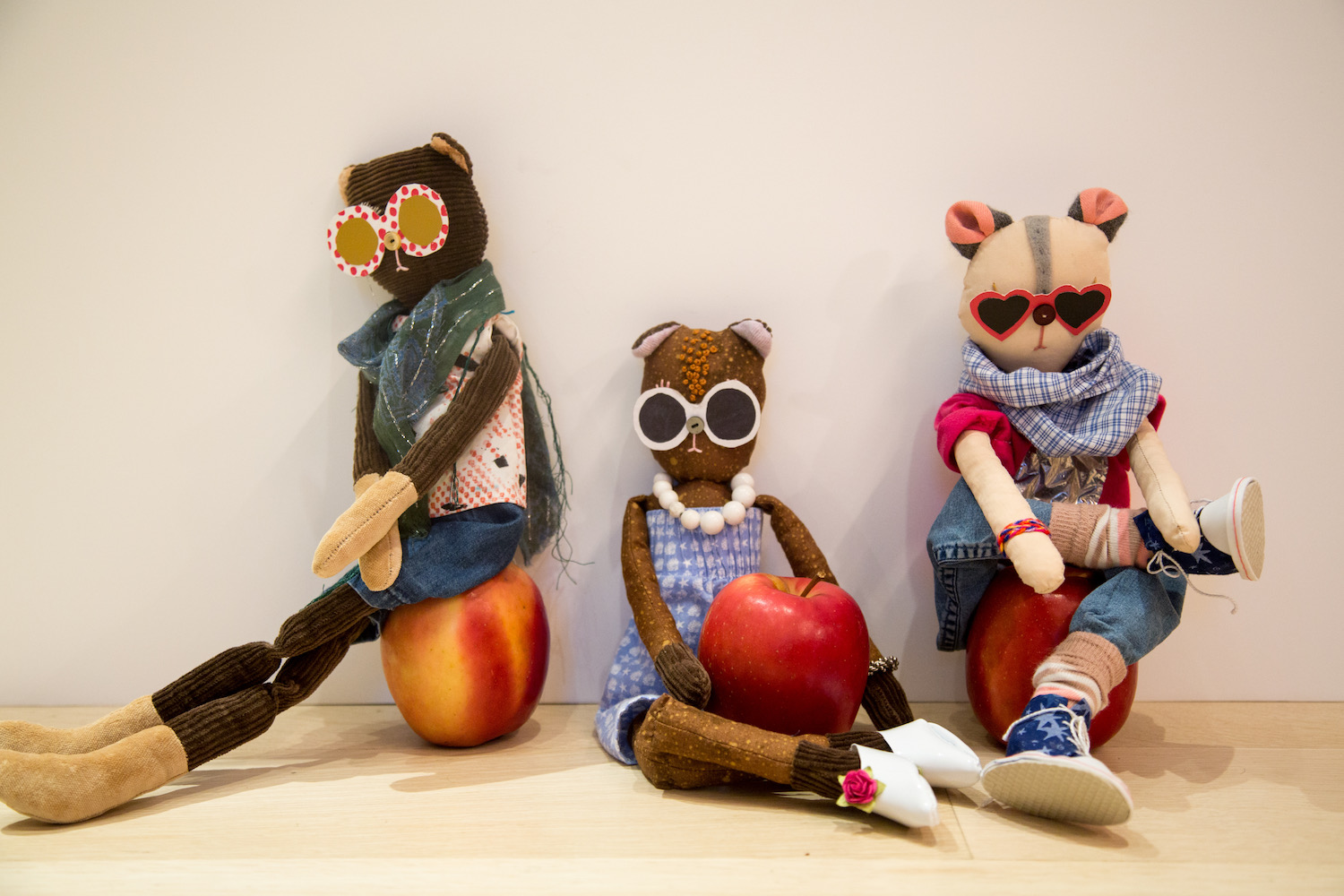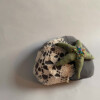
Sea Star #1: Robert Burns
Robert is made from repurposed materials, and is posed on one of my textile rocks.
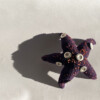
Sea Star #2: Lulu
Lulu is made from repurposed materials. Here she is on one of my textile rocks, and being born. She’s named for a London shop that I’d never heard of, so not sure who gave me the bag—anyone want to claim credit? I do think Lulu Guinness is a perfect name for an elegant echinoderm.
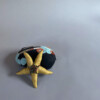
Sea Star #3: Amy
Made from a necktie (remember those?) and a hoodie. Posed with another textile rock.
Did you know that a gathering of sea stars is called a galaxy?
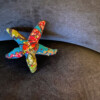
Sea Star #4: Ziggy Starfish
Sea stars aren’t actual fish, so I try to call them sea stars rather than starfish, but Starfish is Ziggy’s stage name.
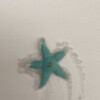
Sea Star #5: Lara
Sea stars can be found in every ocean in the world, the polar as well as the tropical. But not usually in snowstorms
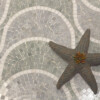
Sea Star #6: Ken
Sea stars live in a wide variety of habitats, including tidal pools, rocky shores, sea grass, kelp beds, and coral reefs. And bathroom floors.
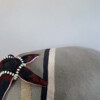
Sea Star #7: Estella. Posed on textile rock
According to Wikipedia, sea stars were assigned the scientific name Asteroidea by French zoologist de Blainville in 1830. The name comes from the Greek aster, ἀστήρ (a star) and eidos, εἶδος (form, likeness, appearance).
Making sea stars is a great way to use up old costume jewelry, btw.
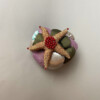
Sea Star #8: Carmine
Almost all species of sea stars have eyes at the ends of their arms. Apparently, they aren’t particularly good eyes, but they can help the sea star to not fall off the reef.
I took apart another necklace in my stash of old jewelry that various friends have given me over the years. Then I noticed that the beads were kind of heavy and I sort of wondered what they’re made of. Any thoughts?
(My son says he’s reminded of the Emily Eyefinger children’s books. Emily is born with an eye on the end of her finger, and although her parents are initially concerned, it turns out to be useful.)
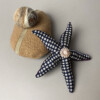
Sea Star #9: Oscar
According to Wikipedia: “The starfish does not have the capacity to plan its actions. If one arm detects an attractive odour, it becomes dominant and temporarily over-rides the other arms to initiate movement towards the prey. The mechanism for this is not fully understood.”
I find this relatable. - Made from old necktie and broken jewelry.
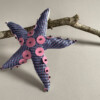
Sea Star #10: Yayoi
Made from necktie and a placemat, with embellishments cut from a vinyl tote bag. Inspired by a workshop at @textileartsite with @jessica_rosestitch, a wonderful textile artist who makes “sequins” out of repurposed materials.
There are over 1900 species of sea star. It’s entirely possible that there’s one that looks like this.
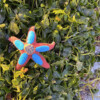
Sea Star #11: Chantal
In the wild, sea stars are mostly carnivorous predators and scavengers. In captivity, some will eat vegetables. - Made from old pants, curtain liner, fleece scraps, necktie scrap.
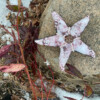
Sea Star #12: Antoinette
Sea stars are harder to spot in cold winter weather, as they move to deeper water or more sheltered locations. - Made from an old bedsheet that I printed on using costume jewelry and fabric on a gel plate many years ago. Plus beads and a vintage wooden button (is that from you, @mammarago?)
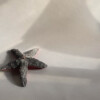
Sea Star #13: Dorian
Sea stars lack brains, but this doesn’t appear to bother them really. They can seem quite contemplative, in my opinion, the way they live in the moment, unhampered by memories or plans. - Made from an old shirt, with a bright pink fabric scrap underbelly.
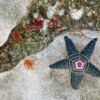
Sea Star #14: Miles
My friend @mammarago just sent me a link to a video of The Artist Formerly Known as Prince performing his song “Starfish and Coffee” with the Muppets. It’s delightful and I recommend you google it. (“Starfish and Coffee” is the sixth track on the album Sign O’ the Times.)
However, as it is after all a song about eating starfish for breakfast, it sent me on an unfortunate exploration of the topic of eating starfish. I do NOT recommend that you google it, I can sum it up for you here: some sea stars are poisonous, they are generally considered an acquired taste, but humans will eat anything.
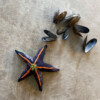
Sea Star #15: Eric
Here’s how a sea star eats a mussel: it pries the shell open with its arms and draws it close with its little tube feet. Then it shoots its stomach out through its mouth and into the shell, enveloping the mussel and breaking it down with digestive acids. When finished with its meal, it retracts its stomach back into its body.
Cannot make this stuff up. - Made from dyed fabric that someone gave me, old pants, felt, plastic drinking straw.
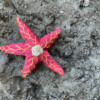
Sea Star #16: Elsa
Does Elsa appear to be posed upon volcanic rock? She wishes. Actually, it’s New York City snow.
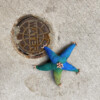
Sea Star #17: Chloe
Sea stars absorb oxygen directly from the saltwater around them, through papulae on their skin and through the tube feet on their undersides. Most sea star species can’t survive out of the water for more than a few seconds.
Breathing through your feet is cool.
Never lift a sea star out of the water.
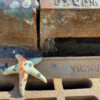
Sea Star #18: Jonathan Livingston Seastar. (My kids didn’t get this reference, so now I’m curious just how obscure is it?—do you have to have been born before say 1965?)
Don’t do it, Jonathan!
There are a few exceptions to the rule that sea stars cannot live out of the water for more than a few seconds. The ochre sea star, Pisaster ochraceus, is unusually tolerant of air and is often exposed for up to 6 hours at low tide.
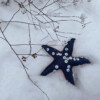
Sea Star #19: Ernest
I found a student study that considered the question of whether sea stars experience Seasonal Affective Disorder (SAD): these students flipped over some sea stars and observed how quickly they righted themselves in different temperatures. Apparently, cold sea stars did so more slowly, which the students took to be evidence of low energy levels, a clear SAD symptom. But perhaps they were just cold. - Made from a necktie and a dismantled shell necklace.
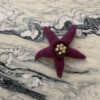
Sea Star #20: Val
According to Wikipedia: Most species of sea star are gonochorous, having separate male and female individuals. Some species are simultaneous hermaphrodites, producing both eggs and sperm. Others are sequential hermaphrodites, starting life as males, then changing into females as they grow older. In some species, a large female can split in half into two male offspring, which eventually turn into females as they grow larger. - Made from a t-shirt, fabric from a bridesmaid’s dress, candy wrapper, and beads from a deconstructed necklace.
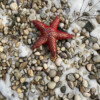
Sea Star #21: Claudette
Although starfish do not have many well-defined sense organs, they are sensitive to touch, light, temperature, orientation and the status of the water around them. - Made from fabric scraps from my bridesmaids’ dresses, plastic mesh clementine bag, beads.
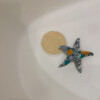
Sea Star #22: Joaquin
One issue with making things out of old bedsheets: their structural integrity is unreliable. Joaquin tore as I was turning him right side out. My immediate reaction was $&@*! But then I recalled the words of the one and only @heidiparkes when I once asked her about using weak fabrics in a quilt. She said to use the fabrics that you love, and if they tear, then you mend it.
This is turning out to be a long post! Sorry. I decided I’d mend Joaquin but hadn’t brought any extra fabric with me on this trip. Then—miraculously—my Quiltcon swag bag held this charm pack of lovely speckled fabric squares, so I used some of that, and gave Joaquin a purely decorative patch as well because he deserves it.
AND this seems an appropriate post to briefly mention sea star resilience. Most sea star species can regenerate lost arms, and a few can even regenerate their entire selves from a portion of a leg.
Hotel room photo shoots pose a challenge, btw. - Made from an old bedsheet I printed on years ago, old pants, speckled fabric by Rashida Coleman-Hale @iamrashidacolemanhale @rubystarsociety
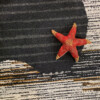
Sea Star #23: Roderick
Sea stars are benthic animals, meaning that they live on the floor. The sea floor, that is, not the hotel hall floor. But Roderick is adaptable. Gotta love hotel carpeting.
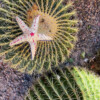
Sea Star #24: Paloma
Sea stars are echinoderms, meaning “spiny skin.” Most have rows of spines or spicules along their top sides to protect them from predators. Kind of like cacti. - Made from gold ribbon and an old hoodie.
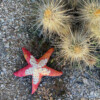
Sea Star #25: Nathan
Sea star fossils are extremely rare, as the hard parts separate and disperse so quickly. Some have been found in the US, in South Dakota, Wyoming, and Montana. Not, as of yet, in Arizona. - Made from dyed? painted? fabric pieces I was given, fleece hoodie, and a cut-up hotel loofah-thing.
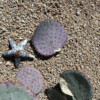
Sea Star #26: Jules
The oldest sea star fossil ever found dates from the Ordovician period, some 480 million years ago.
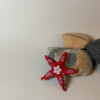
Sea Star #27: Phyllis
Sea star skeletons consist of multiple plates that move like flexible joints, unlike other echinoderms such as sea urchins or sand dollars whose skeletal plates are fused. - Made from fabric scraps and embellished with a plastic spice bottle top, paillettes cut from plastic containers, and beads.
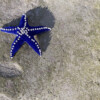
Sea Star #29: Isabella
I previously posted that “echinoderm” comes from the Greek for “spiny skin,” but the Ancient Greek ἐχῖνος (ekhînos) apparently means “hedgehog”.
Btw, there’s usually some obscure reason for the sea star name. Any guesses why she’s named Isabella? - Made from a Volcanica coffee bag, with beads from another deconstructed necklace.
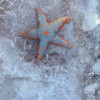
Sea Star #31: Eris
Sea stars are ectotherms, but you can’t really call them “cold-blooded” because they don’t have blood.
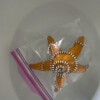
Sea Star #32: Pearl
Made from fabric from the charm pack in my Quiltcon swag bag by @iamrashidacolemanhale @rubystarsociety, and a deconstructed necklace.
Sea stars can’t survive in fresh water.
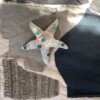
Sea Star #33: Jade
A typical sea star heart beats about six times a minute.
My mother was given this necklace by my grandmother (my mother’s mother-in-law) and she eventually gave it to me. I always thought it was jade. I took it to a jeweler, who said it was plastic, and pointed out how the green color was pulling back from the edges. I think it looks nice on Jade.
(I wrote an essay many years ago that mentions this: http://fullgrownpeople.com/2013/11/22/what-its-worth/) - Made from an old t-shirt and embellished with pieces from a very old necklace.
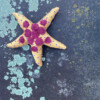
Sea Star #34: Jeannette
I said that sea stars have hearts, which I got from Wikipedia. I think that’s misleading. They don’t have actual “hearts”. They have complex water vascular systems. - Made from an old necktie and a washcloth.
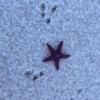
Sea Star #35: Garrick
Sea stars are predators, but they can only eat animals that move more slowly than they do. - Made from an old necktie.
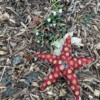
Sea Star #37: Persephone
Sea star can pump their bodies up with cold seawater to lower their body temperature, to stave off heat stress when exposed to the sun at low tide. - Made from an old necktie.
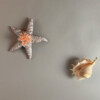
Sea Star #38: Rita
In many areas, sea stars are considered a keystone species, one that preys on animals that have no other natural predators. If a keystone species is eliminated from the environment, their former prey will increase unchecked. - Made from fabric from my #quiltcon swag bag, drinking straws, and beads.
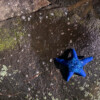
Sea Star #39: Amadeus
I’ve been trying to find out why we in the modern western world tend to draw the stars in the night sky with five points. It seems the depiction can be traced to Ancient Egypt, and according to egyptianmyths.net the Egyptian symbol for the stars was a five-pointed line drawing, “resembling the sea stars . . . that inhabited the Red Sea.” I don’t know that anyone could say with any authority that the hieroglyph was inspired by sea stars. And if it were in fact so inspired, I still don’t understand why those ancient people would have made any connection between a sea creature and something bright in the sky.
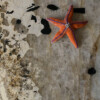
Sea Star #40: Maria
I read that a sea star variety’s color “camouflages the sea star from potential predators and intimidates potential attackers.” I’m not clear on how a color can both camouflage and intimidate at the same time, or what the difference is between a predator and an attacker. - Made from an old t-shirt.
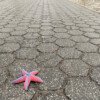
Sea Star #41: M.C
Sea stars typically have five rays or arms. Five-armed sea stars are, geometrically, equilateral concave decagons, and they exhibit pentameral symmetry. - Made from an old t-shirt.
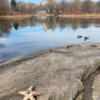
Sea Star #42: William
I came across a debate as to whether or not sea stars feel pain. Sea stars have nervous systems, and are sensitive to light, touch, and temperature. But pain is a complex response processed in the brain. Which sea stars don’t have. What is the difference between sensitivity and pain—is it simply a matter of degree? - Made from an old necktie and very cool beads given to me by @galerothsteindesigns.
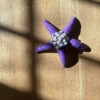
Sea Star #43: Violet
As there are around 2,000 different sea star species, it can be misleading to generalize about them. I try to say “certain sea stars” or “typical sea stars” rather than just “sea stars.” - Made from fabric scraps, embellished with spangles, beads from an old necklace.
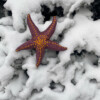
Sea Star #44: Edmund
I’ve done a cursory survey of poems involving sea stars. Many of them have language about holding sea stars, tossing them, etc. Poets: it’s fine to use sea stars as metaphors for whatever, but in actual life, people shouldn’t touch them. - Made from an old necktie.
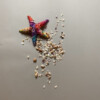
Sea Star #45: Jerome
To the point I made about it being difficult to generalize about the 2000 or so varieties of sea stars: in some areas certain species are critically endangered (such as Pycnopodia helianthoides, the sunflower sea star, found in the northeast Pacific), while others in other areas are considered among the world’s worst invasives (such as Asterias amurensis, also known as the Northern Pacific seastar and Japanese common starfish).
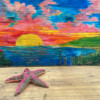
Sea Star #47: Gordon
Sea stars’ shape allows them to quickly change direction without having to turn around. - Made from a quilted jacket from @mammarago.
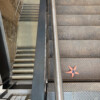
Sea Star #48: Sol
I took Sol with me to MassMoCA. What I really wanted to do was photograph him in James Turrell’s Perfectly Clear (google it!) gallery, but photography is not permitted and he wouldn’t have been allowed to lie on the floor.
Sea stars come in a wide range of colors. While they cannot change their color to camouflage themselves, many have patterning that can resemble the movement of water and light that makes them difficult to spot against a reef.
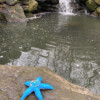
Sea Star #49: Claude
Do sea stars sleep? As far as I can tell from my google search, sea stars are in constant motion and don’t “sleep” in the usual sense. Apparently, traditional “sleep” requires a brain, which, as I’ve mentioned, sea stars don’t have. However, they do enter a state of dormancy known as diapause, which is similar to sleep.
As an aside: In the course of this rigorous research, I came across a definition of the “starfish sleep position,” which occurs when you sleep on your back, with arms outstretched on either side of your head. Interestingly, people who assume the starfish position generally don't appreciate being the center of attention.
True? not true? who can say.
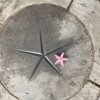
Sea Star #50: Florine
Made from a sweatshirt and beads. These sea stars can be made from almost any fabric scraps as long as they’re not too thick. Fabric with some stretch produces chubbier sea stars.
Or maybe they’re pregnant. Some sea star species breed in the spring, and the females produce millions of eggs which they store in their arms, making them plump and spongy.
Many thanks to @friendsofartpark for suggesting this photo shoot location!
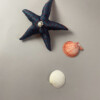
Sea Star #51: Owen
Sea stars have a small, round, hard plate called the madreporite on top of their central discs, through which it draws in seawater and expels water to fuel its vascular system. While water can enter a sea star's body through other pores, the madreporite, also called a sieve plate, functions like a trap door and helps maintain the osmotic pressure needed to maintain the sea star's body structure. - Made from a necktie and fake pearl beads.
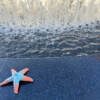
Sea Star #52: Avery
Sea stars have thousands of tube feet on their lower surfaces, arranged in grooves along their arms, which operate through hydraulic pressure and are used for locomotion, feeding, and respiration. - Made from an old bedsheet and beads.
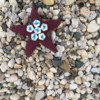
Sea Star #53: Philippa
According to Wilkipedia, this is how a sea star rights itself if flipped upside down by the waves: “two adjacent arms are bent backwards to provide support, the opposite arm is used to stamp the ground while the two remaining arms are raised on either side; finally the stamping arm is released as the starfish turns itself over and recovers its normal stance.” - Made from a pique polo shirt and buttons. (Why do I have pentagonal buttons?)
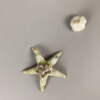
Sea Star #54: Madeleine
One interesting variety of sea star, the leather sea star (Dermasterias imbricata), named for its leathery skin (definitely google it!) is found off the western seaboard of North America. Leather sea stars can grow to about 12 inches in diameter and have a distinctive smell that resembles garlic and sulphur. - Made from an old bedsheet that I printed on only semi-successfully a number of years ago, embellished with pentagons cut from a very well-worn much-loved shoe by @rothys.
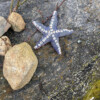
Sea Star #55: Theo
Sea stars range in size from a diameter of less than ½ an inch (the paddle-spined sea star) to 40 inches across (the sunflower sea star). - Made from an old necktie and beads from a deconstructed necklace.
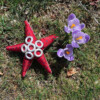
Sea Star #56: Louise
Some sea star species have pedicellariae on their bodies, which are compound ossicles with forceps-like jaws. They remove debris from the body surface and wave around on flexible stalks in response to physical or chemical stimuli while continually making biting movements. - Made from an old necktie and some thingies. I don’t know what the thingies were for, but I have a whole bag of them. I think they came from a jewelry supply company that went out of business and donated boxes of stuff to the art school I was attending.
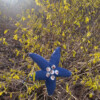
Sea Star #57: Margot
Sea star babies (larvae) are nearly invisible to the naked eye. After a month or two they begin to transform from blobs into stars. - Made from an old t-shirt, with spangles and beads.
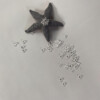
Sea Star #58: Adriana
@adamandia_k alerted me to an article in @artnews about an archeological discovery made earlier this month in Mexico City at the Templo Mayor, the former ancient capital of Tenochtitlan: a ritual offering of about 160 sea stars surrounding the skeleton of a jaguar. “Like the majority of the offerings found at the Templo Mayor, the starfish were dedicated to the two-sided god Huehueteotl-Xiuhtecuhtli, who represents both water and fire, agriculture and war.” - Made from an old sweater.
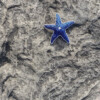
Sea Star #60: Derek
Sea stars apparently have an unusual ability to expel foreign objects from their bodies, which makes them difficult to tag for research tracking purposes - Made from an old necktie, embellished with fake pearl beads.
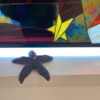
Sea Star #61: Christopher
There are a number of articles online about how to decorate sea stars. When I was a child we had a dried sea star Christmas tree ornament that was given to me by a friend. It had glitter on it. The thought of it makes me sad. - Made from an t-shirt.
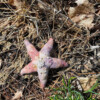
Sea Star #62: April
These sea stars I’m making aren’t really meant to emulate real sea stars. Real sea stars are far more fancifully designed. If you have a chance, look up chocolate chip sea star, Panamic cushion star, candy cane sea star, just for starters. - Made from fabric dyed with botanicals by @thehoopnyc.
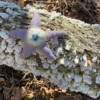
Sea Star #63: Hope
As previously mentioned, sea stars are echinoderms, meaning "spiny skinned," but not all sea stars are in fact spiny. The sun star, Solaster stimpsoni, found in the seas of Japan and along the western coast of the United States, has relatively smooth skin. - Made from a fabric woven by @thehoopnyc.
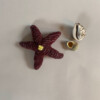
Sea Star #64: Jasper
Sea stars are related to sand dollars, sea urchins, and sea cucumbers. Have you ever seen a sea cucumber? Maybe I’ll do a 100 Sea Cucumber Project next. - Made from an old sock.
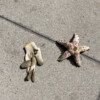
Sea Star #65: Narcissa
Made from fabric dyed with botanicals by @thehoopnyc.
Sea stars are polygamous.
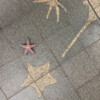
Sea Star #66: Harriet
Sea stars most likely evolved from ancient animals called crinoids that lived 250 million years before dinosaurs. The five arms of starfish are a relic left over from these ancestors. - Made from an old necktie.
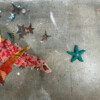
Sea Star #67: Hunter
Biologists Don Wobber and John Pearse have shown on film that sea stars use their arms to interact with each other, seemingly sizing each other up by touch, and defending territory. - Made from an old fleece pullover. Posed with “Detritus (Crater, Constellation, Tongue)” by @jessicawillittes (thank you Jessica!) I recommend this show: @huntercollegemfathesis. Thank you @artime_ny for taking me.
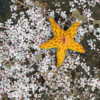
Sea Star #68: Ketanji
Any one tube foot on a sea star can act autonomously in responding to stimuli, but many feet can synchronize to produce a bouncing motion. Researchers are investigating how a sea star accomplishes this synchronization, given it has no brain and a completely decentralized nervous system. Understanding how sea stars achieve complex, coordinated motions could lead to advancements in areas such as robotics.
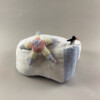
Sea Star #69: Adele
The most common sea star in Antarctica is Odontaster validus. Evidence suggests this species may live as long as 100 years. Its unusual longevity is due to its low metabolic rate, the result of the harsh environment in which it lives. - Made of fabric woven by @thehoopnyc. Posed on a textile iceberg I made many years ago. Penguin not to scale.
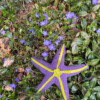
Sea Star #70: Quintus
From an article by John H. Lienhard, “Five-Fold Symmetry”: “Nature offers so much pentagonal symmetry: the armor of pineapples, cross sections of apples -- starfish, flowers, sand dollars. But we also force five-fold symmetry on many things. The Greeks spoke of five Platonic solids: cubes, octahedrons, tetrahedrons, icosahedrons, and dodecahedrons. The first four (formed from triangles or squares) stood for earth, air, fire, and water. But the fifth, the dodecahedron (made from pentagons) was the symbol for pure celestial matter.” - Made of an old pique polo shirt and an old shoe.
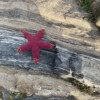
Sea Star #71: Austin
The ochre sea star, or purple sea star, Pisaster ochraceus, is one of the most iconic tidepool species of the eastern North Pacific and can be bright orange, purple, or brown. Researchers have attempted to learn what causes the polymorphism, but have not been able to reach a clear conclusion: some think it’s due to diet, others to habitat, or genetic variation. So, after a whole lot of research and analysis, scientists have no clue. - Made from a t-shirt.
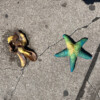
Sea Star #72: Chiquita
After 72 days of a sea star project, one starts to spot sea creatures all over the place.
If you google “sea star banana peel” you’ll find a video in which two sea stars gently touch and then one of them makes itself look like a banana peel. Not to be missed.
(There doesn’t seem to be such a thing as a banana sea star. There is such a thing as a banana slug. It looks like what you’d think it would, no need to look it up.)
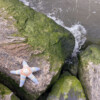
Sea Star #73: Arachne
Apparently, a sea star’s tube feet contain a glue-like substance, which can secure the sea star to objects like rocks so that they don’t fall off or get washed away. The feet will then secrete a solvent once the sea star needs to move somewhere else. - Made from fabric woven by @thehoopnyc.
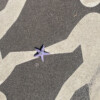
Sea Star #74: Leonardo
The ancestors of echinoderms in the Cambrian period were bilaterally symmetrical. Sea star larvae are bilateral during their early life, but develop pentameral symmetry as they mature. Apparently, sea stars may revert to bilateral tendencies when under stress. - Made from an old shirt.
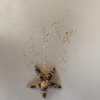
Sea Star #75: Moses
The Petco website sells five types of echinoderm, only three are sea stars and the other two are brittle stars, which are related but different. The sea stars range in price from $14.99 to $21.99.
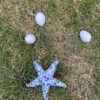
Sea Star #76: Pascal
Many sea stars are “broadcast spawners”: males release sperm into the water and females release eggs, sometimes in the millions. Eggs are fertilized in the water and hatch into larvae that swim freely as zooplankton, sometimes for months, before settling on the sea floor in adult form. - Made of a shirt I painted on a long time ago.
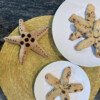
Sea Star #76: Pascal
Many sea stars are “broadcast spawners”: males release sperm into the water and females release eggs, sometimes in the millions. Eggs are fertilized in the water and hatch into larvae that swim freely as zooplankton, sometimes for months, before settling on the sea floor in adult form. - Made of a shirt I painted on a long time ago.
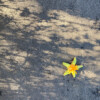
Sea Star #78: Eleanor
Today, a sea star poem for you:
Starfish
By Eleanor Lerman
This is what life does. It lets you walk up to
the store to buy breakfast and the paper, on a
stiff knee. It lets you choose the way you have
your eggs, your coffee. Then it sits a fisherman
down beside you at the counter who says, Last night,
the channel was full of starfish. And you wonder,
is this a message, finally, or just another day?
Life lets you take the dog for a walk down to the
pond, where whole generations of biological
processes are boiling beneath the mud. Reeds
speak to you of the natural world: they whisper,
they sing. And herons pass by. Are you old
enough to appreciate the moment? Too old?
There is movement beneath the water, but it
may be nothing. There may be nothing going on.
And then life suggests that you remember the
years you ran around, the years you developed
a shocking lifestyle, advocated careless abandon,
owned a chilly heart. Upon reflection, you are
genuinely surprised to find how quiet you have
become. And then life lets you go home to think
about all this. Which you do, for quite a long time.
Later, you wake up beside your old love, the one
who never had any conditions, the one who waited
you out. This is life’s way of letting you know that
you are lucky. (It won’t give you smart or brave,
so you’ll have to settle for lucky.) Because you
were born at a good time. Because you were able
to listen when people spoke to you. Because you
stopped when you should have and started again.
So life lets you have a sandwich, and pie for your
late night dessert. (Pie for the dog, as well.) And
then life sends you back to bed, to dreamland,
while outside, the starfish drift through the channel,
with smiles on their starry faces as they head
out to deep water, to the far and boundless sea.
(From Our Post-Soviet History Unfolds, Eleanor Lerman 2005)
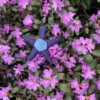
Sea Star #79: Isaac
In addition to the eye spots on the ends of their arms, some sea stars also possess individual photoreceptor cells in other parts of their bodies and respond to light even when their eyespots are covered. Whether they advance towards or retreat from the detected light depends on the species. - Made from a fabric scrap from @fab_scrap and a glove my husband received free in the mail.
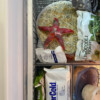
Sea Star #80: Swanson
Some sea stars use cold sea water to regulate their body temperature. Apparently they are cued during low tide if the temperature is high, and that signals them to soak up more cold water during the next high tide. The amount of water a sea star absorbs can decrease its body temperature by almost 4 degrees Celsius. This strategy will lose effectiveness as oceans warm. - Made from a shirt I painted on years ago. With acrylic paint, which makes it annoying to sew.
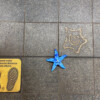
Sea Star #81: Jackson
Another one made from a shirt I painted on.
There is some evidence that sea stars cannot read.
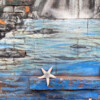
Sea Star #82: Roxane
Sea stars have an unusual ability to expel foreign objects from their bodies, making them difficult to tag for research tracking purposes. - Made from fabric left over from my bridesmaids’ dresses.
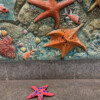
Sea Star #83: Scarlett
Because of its multiple arms, the sea star provides a popular metaphor for computer networks, companies, and software tools - Made from a pique shirt and embellished with circles cut from a plastic lid.
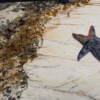
Sea Star #84: Loren
A number of people have mentioned to me what is often called “The Starfish Story” or some variation of that, which is an adaptation of Loren Eiseley’s 1969 essay, “The Star Thrower.” The adaptation, often cited by motivational speakers, often without attribution, essentially is this:
“One day a man was walking along the beach when he noticed a boy picking something up and gently throwing it into the ocean. Approaching the boy, he asked, “What are you doing?” The youth replied, ‘Throwing starfish back into the ocean. The surf is up and the tide is going out. If I don’t throw them back, they’ll die.’ ‘Son,’ the man said, ‘don’t you realize there are miles and miles of beach and hundreds of starfish? You can’t make a difference!’
After listening politely, the boy bent down, picked up another starfish, and threw it back into the surf. Then, smiling at the man, he said…’I made a difference for that one.’”
I want to say that sea stars should NEVER be thrown.
Made from a scrap of dyed fabric, inside out.
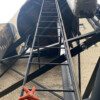
Sea Star #85: Alex
As promised, here’s an excerpt from Loren Eiseley’s 1969 essay, “The Star Thrower.”
In a pool of sand and silt a starfish had thrust its arms up stiffly and was holding its body away from the stifling mud.
"It's still alive," I ventured.
"Yes," he said, and with a quick yet gentle movement he picked up the star and spun it over my head and far out into the sea. It sunk in a burst of spume, and the waters roared once more.
..."There are not many who come this far," I said, groping in a sudden embarrassment for words. "Do you collect?"
"Only like this," he said softly, gesturing amidst the wreckage of the shore. "And only for the living." He stooped again, oblivious of my curiosity, and skipped another star neatly across the water. "The stars," he said, "throw well. One can help them."
..."I do not collect," I said uncomfortably, the wind beating at my garments. "Neither the living nor the dead. I gave it up a long time ago. Death is the only successful collector."
But again, please don’t spin or skip sea stars.
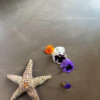
Sea Star #86: Georgia
There are seven extant orders of sea stars; Brisingida, Forcipulatida, Notomyotida, Paxillosida, Spinulosida, Valvatida and Velatida; and two extinct ones, Calliasterellidae and Trichasteropsida.
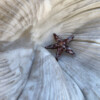
Sea Star #87: Françoise
My friend Isabelle @milkisa61 is visiting from Paris, and when I see her I always try out my schoolgirl French on her just to be annoying. I guessed that “étoile de mer” is how you say “sea star” in French, and ha I was right. Do you want to know how to say “echinoderm” in French? Of course you do. It’s “échinoderme.” I could’ve guessed that, too. - Made from fabric that I painted with acrylic paint. Posed against Jon Isherwood’s beautiful public sculpture, “A Chance’s Wish.” @jonisherwoodonbroadway @broadwaymallassociation
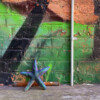
Sea Star #88: Elon
Sea stars produce saponins—bitter-tasting chemicals that have a foamy quality when agitated in water. Plants are the main sources of saponins, but sea stars contribute as well. Some 400 different saponins have been purified from sea stars which have been found to have toxic, hemolytic (relating to destruction of red blood cells), antifungal, antiviral and anti-inflammatory effects. - Made from fabric I got free for volunteering at @fab_scrap.

Sea Star #89: Camille
In my random sea star research I came across this question: “Do starfish get tired?” The answer provided was “The easiest answer for this is no. Starfish do not sleep.” As is so often the case, this easy answer isn’t an answer at all, for the question was NOT “Do starfish sleep.” The question was “Do starfish get tired?” which is completely different, and I would argue that if in fact they don’t sleep then of course they must be tired. - Made from a painted fabric scrap. Posed against Jon Isherwood’s dramatic “As Always Yours.” @jonisherwoodonbroadway @broadwaymallassociation
![Made from a necktie. In a book published in 1705, Georg Eberhard Rumpf, a botanist employed by the Dutch East India Company, described the types of Stella Marina or Bintang Laut ("Sea Star" in Latin and Malay) found in the waters around Ambon Island in Indonesia. He noted that the Histoire des Antilles reported that when the sea stars "see thunder storms approaching, [they] grab hold of many small stones with their little legs, looking to ... hold themselves down as if with anchors".](https://carolpaik.com/wp-content/uploads/cache/2023/02/100Stars_-10/710689065.jpg)
Sea Star #90: Marina
Made from a necktie. In a book published in 1705, Georg Eberhard Rumpf, a botanist employed by the Dutch East India Company, described the types of Stella Marina or Bintang Laut ("Sea Star" in Latin and Malay) found in the waters around Ambon Island in Indonesia. He noted that the Histoire des Antilles reported that when the sea stars "see thunder storms approaching, [they] grab hold of many small stones with their little legs, looking to ... hold themselves down as if with anchors".
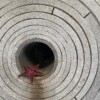
Sea Star #91: Andrew
Made from a fabric scrap I got free for volunteering at @fab_scrap. Posed against Andy Goldsworthy’s “Watershed.” #andygoldsworthywatershed
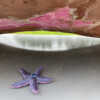
Sea Star #92: Emma
Researchers at Plymouth University have recently observed the species Asterias rubens rolling along the seabed with arms curled into a spheroid shape –- a phenomenon they've termed 'starballing'. Some were recorded raising a single arm into the water column prior to moving as if to test the conditions. Dr Emma Sheehan, a Research Fellow in Plymouth's Marine Institute, said: "The common starfish is naturally a slow-mover . . . Its larvae have therefore long been considered as the reason the species is so widespread throughout the North Atlantic. But this newly-observed phenomenon of 'starballing' might both shed further light on their distribution and explain how mass strandings occur." - Made from an old necktie. Posed with “The Wild Within” by Rachel Mica Weiss (google it!). @rachelmicaweiss

Sea Star #93: Renée
Sea stars have a remarkable ability to regenerate lost limbs. But some species can also regenerate an entire body from a severed ray, as long as part of the central disk remains. So it can be difficult to say which came first, the sea star or the arm. - Made from an old hoodie.
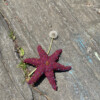
Sea Star #94: Hector
While we tend to think of sea stars as having five arms, six-armed sea stars are not that uncommon. Six-armed species include Lepasterias hexactis, commonly known as the six-rayed star, which is found in the intertidal zone of the western seaboard of the United States; and the rarely-seen Luidia penangensis of the Western Central Pacific (Philippines, Singapore, Thailand). - Made from an old t-shirt.
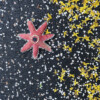
Sea Star #95: Cecilia
Luidia ciliaris, the seven-armed sea star, is found in the eastern Atlantic Ocean from Norway to Cape Verde and in the Mediterranean Sea. The seven-armed sea star can hoist itself up on the tips of its arms and “walk,” which allows it to move more quickly than other species. - Made from vintage velvet.
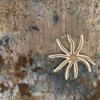
Sea Star #96: Nina
Luidia senegalensis, the nine-armed sea star, is found around the coasts of Florida, in the Caribbean Sea, the Gulf of Mexico, and along the coast of South America to southern Brazil. - Made from an old t-shirt.
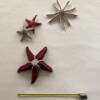
Sea Star #97: Ariana
Sea stars come in a wide array of sizes.
Some people who have seen the sea stars IRL have commented that they’re larger than they expected them to be, so I thought I’d clarify things. Sea stars 1 through 92 are all the same size. Ariana is grander. - Made from an old sweater. Posed with some of her colleagues.
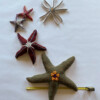
Sea Star #98: Rio
When making these sea stars I’ve relied upon the materials at hand and my imagination for the designs, but there have been times in the course of this project when after I made a sea star I would then come across an image of an actual one that resembled it, except crazier. My imagination is so limited compared to the infinite wonders of the natural world—I mean, who could dream up such a thing as a star-shaped creature that comes in rainbow colors, has eyes on the ends of its arms, and moves around on hundreds of sticky tube feet. If you’re an artist seeking inspiration, or anyone who wants to be delighted and awed, I recommend taking a dive into sea star images online. - Made from an old ExOfficio t-shirt. Rio may still be somewhat mosquito-repellent. Thank you @anncofta for the cool buttons!
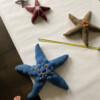
Sea Star #99: Penultima
Penultima is a bit of a diva, harder to wrangle than the others. Here you see her at her photo shoot, getting out of hand. Kind of like this project.
I can’t do a sea star series without mentioning the incredible sunflower sea star, Pycnopodia helianthoides, one of the largest sea stars in the world, which has 16 to 24 limbs and can grow to be 39 inches from tip to tip.
Penny is not a sunflower sea star. I was going to make one, but 16 to 24 arms were more arms than I could manage in a way that pleased me, I would have had to use a different method of construction, so I just made Penny instead, but I’m going to slip in some info about sunflower sea stars anyway.
Sunflower sea stars were once common in the northeast Pacific from Alaska to southern California, but between 2013–2015 the population declined dramatically due to sea star wasting disease and warmer water temperatures. The species disappeared altogether from the waters off the coasts of California and Oregon, and was reduced by 99.2% in the waters near Washington. As of 2020, the sunflower sea star is officially considered critically endangered.
If you google “sea star wasting disease”, you will see some sad photos. - Made from an old sweater of my dad’s.
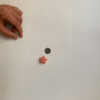
Sea Star #100: Scintilla
Posed with a penny I found on the ground a few days ago.
The world’s smallest sea star, the paddle-spined sea star (Patiriella parvivipara), measures less than 1/2 inch across. It was discovered relatively recently, in 2007, by an amateur naturalist in southern Australia who spotted one while looking for sea slugs in the seaweed.
I love true stories far better than fantasies or fables. This one reminds that wonders exist all around us and we may be able to detect them if we keep our eyes (ears, minds, hearts) open. Even (or maybe especially?) while searching for slugs.





